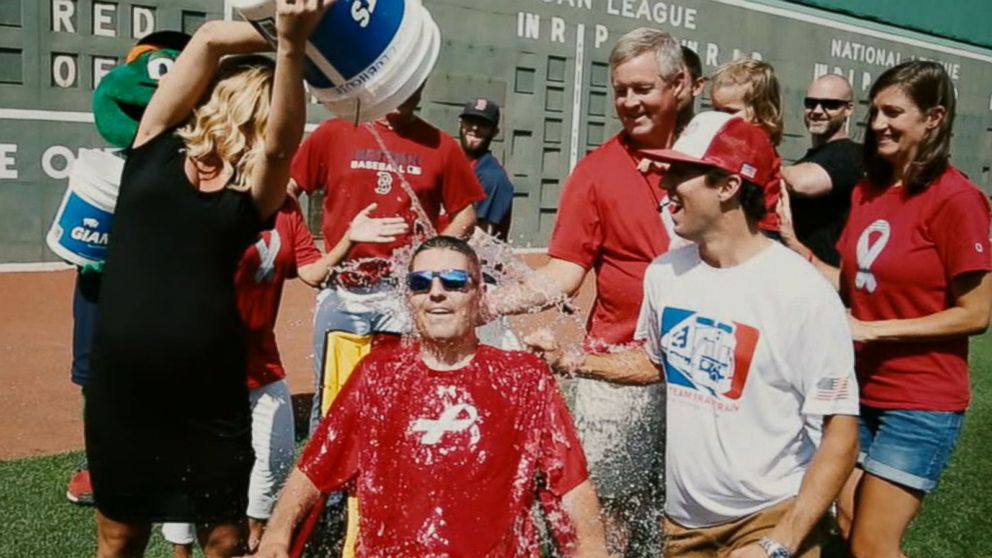
“I’m going to change the face of this unacceptable situation of ALS. We’re going to move the needle and raise money to fight.”
If you had a Facebook account during the summer of 2014, it was impossible not to view one of the numerous Ice Bucket Challenge videos. In just two short months, this phenomenon had become the most successful social media campaign in the history of the world. Seventeen million of these short videos were posted on Facebook. These videos were watched by 440 million people in 150 countries. Cumulatively, the Ice Bucket Challenge videos were viewed more than 10 billion times.
This is how it worked. A person would fill a bucket with some ice cubes and some water. This person would then dump the bucket of freezing water over her/his head. It was immediately followed by a familiar challenge that essentially said, “I am doing this to raise awareness for ALS. I challenge the following three people to do the same thing or donate $100 to the ALS Foundation or both. You have 24 hours.” This person then tagged three individuals in the Facebook video with the #ALSIceBucketChallenge.
 The Ice Bucket Challenge raised $160 million for the ALS Foundation in just two months. To date, that number has ballooned to $220 million and is still growing. The idea was simple, it was fun, and it was effective. This movement changed the trajectory of research to cure ALS, a relatively obscure and very deadly muscle degenerative disease. Still, most people have no idea how this movement got started. Most have never heard the name, Pete Frates – the man behind the Ice Bucket Challenge.
The Ice Bucket Challenge raised $160 million for the ALS Foundation in just two months. To date, that number has ballooned to $220 million and is still growing. The idea was simple, it was fun, and it was effective. This movement changed the trajectory of research to cure ALS, a relatively obscure and very deadly muscle degenerative disease. Still, most people have no idea how this movement got started. Most have never heard the name, Pete Frates – the man behind the Ice Bucket Challenge.
Pete Frates was the second of three children of John and Nancy Frates. While still in elementary school, a physical education teacher grabbed Pete’s parents and said, “We call kids like Pete ‘One in Ten Thousand’.” Another teacher told his parents, “You know he has IT, you know that, right? He has IT.” What this educator and others were referring to is the right combination of compassion, athleticism, and leadership.
Pete was the classic 3-sport athlete who never specialized in one sport. During his senior year, he was the captain of the hockey team, football team and baseball team at St. John’s Prep in Beverly, Massachusetts. As he entered his senior year in high school, Pete sought an athletic scholarship to play baseball. He was determined to follow in his parents’ footsteps by attending Boston College. This, of course, was surprising news to head coach, Pete Hughes. “If the young man could not crack the starting lineup in high school,” he later said, “What were the chances that Pete could play at a D-1 program like Boston College?”
 Little did this coach know that Pete would lead his Boston College team in home runs and stolen bases during his junior and senior years and eventually become team captain. As all of this played out, the coach developed a different view of Pete. “Pete brings a ton of energy to our team. He’s a leader and plays incredibly hard.” Nevertheless, upon graduation, Pete went undrafted. He played in Europe for a while and then returned home to play for the Lexington Blue Sox, a semi-pro team just outside of Boston. Pete knew that he was never going to gear up for a major league team, but he couldn’t bring himself to give up the game he loved. He sold insurance by day and played baseball by night.
Little did this coach know that Pete would lead his Boston College team in home runs and stolen bases during his junior and senior years and eventually become team captain. As all of this played out, the coach developed a different view of Pete. “Pete brings a ton of energy to our team. He’s a leader and plays incredibly hard.” Nevertheless, upon graduation, Pete went undrafted. He played in Europe for a while and then returned home to play for the Lexington Blue Sox, a semi-pro team just outside of Boston. Pete knew that he was never going to gear up for a major league team, but he couldn’t bring himself to give up the game he loved. He sold insurance by day and played baseball by night.
Then, early in the 2012 season, Pete’s batting average dropped by about 100 points. He began to notice other strange symptoms. He had trouble buttoning his shirt and holding silverware. He felt exhausted much of the time and his legs would give out on him for no apparent reason. In fact, one friend mistakenly thought Pete was drunk after he stumbled home from a local bar. Pete responded, “I wasn’t drunk last night. Something’s wrong. Something’s happening to me.”
Pete began scheduling medical appointments. After a battery of tests, the doctors asked Pete to come in to discuss their diagnosis. Pete asked his parents to join him. “I don’t know how to tell a twenty-seven-year-old this,” the doctor said. “Pete, you have ALS.” His parents asked the doctor for the treatment plan. “Mr. and Mrs. Frates,” the doctor began. “I’m sorry to tell you this, but there’s no treatment and there’s no cure.” Pete’s mother ran out of the room and screamed “Oh my God! My son’s going to die.”
ALS stands for Amyotrophic Lateral Sclerosis, which translates in Latin to “no muscle nourishment.” Most people know it as Lou Gehrig’s disease because the famous New York Yankee athlete was diagnosed with this disease in the prime of his career. On average fifteen people are diagnosed with this disease daily in the United States. The life expectancy of a person diagnosed with ALS is 1,000 days.
True to form, Pete maintained a positive attitude. He was determined to beat the disease. And once a leader, always a leader. Within a few days of his diagnosis, Pete gathered his family and set the tone. “What an amazing opportunity we now have to change the world,” Pete said. “I’m going to change the face of this unacceptable situation of ALS. We’re going to move the needle and raise money to fight.”
Just like he fought his way onto the Boston College baseball team, Pete finagled an appointment with one of the top ALS doctors in the world, Dr. Merit Cudkowicz. During the exam, Pete asked, “How close are you to finding a cure?” She responded by telling Pete that there was not enough money to properly research a cure. Pete asked directly “How much do you need.” Doctor Cudkowicz replied, “I don’t know, Pete. Probably a billion dollars.” Pete looked her in the eyes and said, “I’m going to get working on that.”
And, he did. Pete was never more focused than he was at that moment. Pete believed that this was his purpose in life. “There’s a reason why I’m so young and got diagnosed with it,” he said. “I want to get out there and captivate people and get some momentum for this disease. I’m going to change this disease forever.”
 Pete maintained a positive attitude and kept living life to the fullest extent possible. He made a bucket list of things to do while he still had strength. He traveled. He bought a boat. He went to work for Boston College as the director of baseball operations. In June of 2013, Pete married his girlfriend, Julie. In 2014, Julie gave birth to their daughter, Lucy. Becoming a father meant everything to Pete. Lucy has become his purpose for living. Pete was determined to defy the odds and watch Lucy grow into a young woman.
Pete maintained a positive attitude and kept living life to the fullest extent possible. He made a bucket list of things to do while he still had strength. He traveled. He bought a boat. He went to work for Boston College as the director of baseball operations. In June of 2013, Pete married his girlfriend, Julie. In 2014, Julie gave birth to their daughter, Lucy. Becoming a father meant everything to Pete. Lucy has become his purpose for living. Pete was determined to defy the odds and watch Lucy grow into a young woman.
In the summer of 2014, Pete watched a video of a friend dumping water on his own head. Pete smiled and said, “This is exactly what we’ve been waiting for. This is it!” Pete asked his brother, Andrew, to go to the gas station and buy a bag of ice. Andrew then ran out in the rain and dumped ice water over his head from a dirty trash can. He then challenged his dad and the ALS Ice Bucket Challenge was off and running. The videos started pouring in and Pete began “liking” each video on Facebook and tagging his vast array of powerful supporters. Some 17 million videos later, this phenomenon had raised $220 million dollars to help fight ALS. Amazing.
 Please understand, this disease has not shown Pete Frates any mercy. ALS treated him like every other unlucky soul with this diagnosis. This 6’ 2’’ 225-pound young man suffered greatly. At first, his speech slurred, he fell frequently, and his fingers lost their agility. As time progressed, he needed a wheelchair. He could no longer feed or bathe himself. As the disease progressed, his organs broke down one by one. Pete lost his ability to speak, his ability to control his bowels, and his ability to breathe without assistance from a ventilator. As 2018 ended, Pete — a husband and father — was virtually a prisoner in his own body. He was unable to move or communicate. Pete required around-the-clock care costing his family about $90,000 a month on medical bills. Nothing about ALS is easy or fair. And, so, just like so many victims before him, on December 9, 2019, Pete Frates died.
Please understand, this disease has not shown Pete Frates any mercy. ALS treated him like every other unlucky soul with this diagnosis. This 6’ 2’’ 225-pound young man suffered greatly. At first, his speech slurred, he fell frequently, and his fingers lost their agility. As time progressed, he needed a wheelchair. He could no longer feed or bathe himself. As the disease progressed, his organs broke down one by one. Pete lost his ability to speak, his ability to control his bowels, and his ability to breathe without assistance from a ventilator. As 2018 ended, Pete — a husband and father — was virtually a prisoner in his own body. He was unable to move or communicate. Pete required around-the-clock care costing his family about $90,000 a month on medical bills. Nothing about ALS is easy or fair. And, so, just like so many victims before him, on December 9, 2019, Pete Frates died.
Pete ultimately lost his battle with ALS, but his dream remains alive. Pete didn’t want one more person to be diagnosed with the death sentence known as ALS. Pete was irate that, over the 75 years since Lou Gehrig’s Disease became recognized widely by the public, its course and consequences have remained unchanged. As his former coach said, “It’s known as Lou Gehrig’s disease, but it will be known as Pete Frates’ cure.” It’s now up to us to keep the legacy of Pete Frates alive. If you can donate money to help fund a cure for ALS, please go to www.petefrates.com or http://www.alsa.org/donate/.
Discussion Questions
- Pete had a dream of playing baseball in college. When he received zero scholarship offers, what did he do? How did it work out?
- What were the signs that let Pete know something was wrong with his body health-wise?
- After being diagnosed with ALS, how did Pete respond?
- How did Pete come up with the idea of the ALS Ice Bucket Challenge? How much money has it raised?
- If you were diagnosed with a terminal illness, how would you respond (honestly)?
- What inspires you about Pete and how can his life make you a better person?

Pete worked his butt off until he lead his Boston College baseball team in home runs and stollen bases both his junior and senior year. He began losing strength in his hands and started stumbling when he walked. Pete wanted to raise awareness for ALS and he worked harder than ever. He also created a bucket list. He saw a video of his friend dumping water on his own head. I would probably be depressed for a little bit but then come out of it and pull myself together to live my life the best I could. Pete inspires me to be a better person because he showed me that no matter my situation I can always be strong and be better.
He was determined to follow his parents footsteps and be a leader on the team and he ended up playing at Boston college. No it being able to move his hand properly to being able y9 button up his shirt and being more fatigue. He respond the same way has he was in high school resort to being a leader. Pete came up with the idea while he was watching tv and he saw some person dump, and ice bucket on there head and though it was a good idea to do that for ALS. At the end he ultimately made around 220 million dollars. If I was I don’t think I would person do what Pete did I think at the end of the day I would just give up hope. Just seeing how Pete reacted to the news he wasn’t mad he wanted to do something about for other peopl;le who where suffering.
1. Pete kept working at his goals in life, and joined a smaller team, even though he wasn’t able to join the team he wanted.
2. He started getting weaker, worse batting abilities, his leg as randomly giving out, and not even being able to hold silverware.
3. After getting diagnosed Pete stayed motivated and still did his best to be a leader, and try to raise money to help fight ALS.
4. He got the idea from a video his friend sent him, and he was able to raise $220 million dollars.
5. I probably would not listen to very many people anymore, if I only have a small amount of time left I want to do the things that I want.
6. Pete was able to raise millions of dollars for his cause and that’s nice to know that it is possible.
1. He still fought and didn’t give up. He came up with ideas to still make a difference be be successful in his eyes. He wanted to always make a difference whether he had the disease or not and nothing was going to stop him.
2. When is hitting points dropped drastically and when he was coming home from the bar with his friends he couldn’t walk normally but he wasn’t drunk.
3. He responded greatly even though there was a huge chance that he was going to die in the end he wasn’t going to sit and be sad he wanted to make a difference so no one else would have to die from ASL. So he started coming up with plans.
4. He came up with the idea with his dad in a way because when he was outside one time he poured ice water on with a video and his dad did too and it went viral. He raised $220 million.
5. I think I would go into a deep depression but depending who is around me I would get back up and work with what I have and the time I have.
6. He inspires me to be a better person by not giving up even when your knocked down. To get back up and still work on accomplishments and goals.
Pete worked very hard to become a more skilled player that would be seen as a valuable asset to the team. This shaped a new image of Pete in Hughes’ mind as his energy and will to improve showed his value as a player.
Pete noticed a drop in his batting average first, he felt exhausted more often, couldn’t hold silverware, struggled to button his shirt, and often his legs would give out for no apparent reason.
Pete didn’t lose hope. He saw his diagnosis as an opportunity to raise money for ALS research using his youth to help spread awareness.
The ice bucket challenge was prompted by a video Pete watched of his friend pouring water on his head in the summer of 2014. The challenge has raised 220 million dollars for ALS research.
I would honestly just work towards setting up my assets to better assist those I care about when I pass.
Pete’s story doesn’t really prompt a change in my view of terminal illnesses. A positive outlook didn’t save Pete’s life, but it may have saved the lives of others.
1. He turned down the other baseball scholarships and attended Boston collage and later kept working and went to join the team.
2. When his batting average dropped by 100 points and he struggled buttoning his shirt and holding silverware and he kept stumbling.
3. He gathered his family and they made a game plan to fight this disease and raise awareness and money for the research of the disease.
4. He came up with the idea when a friend dumped a bucket of water on his own head and its raised 220 million dollars and rising.
5. I would probably freak out and loose my calm but I would feel better due to the amount of research that has been done and I would try my best to be calm.
6. To never give up no matter what and to be positive about every situation.
1 Pete worked hard to be better and was able to accomplish that.
2 He couldn’t button his shirts, he struggled with batting and his legs would give out randomly and was getting weaker.
3 He wanted to change it and raise money so they could find a cure for it and so he could beat it. He wanted to be positive and wanted to continue to be a leader.
4 He watched a video of a friend dumping water on his head and knew that is what needed to happen.and raised 220 million dollars.
5 At first I would be upset but Then I would try to stay positive and try to live my life the best I can before I get worse.
6 Pete continued to fight and the disease didn’t stop him. He did his normal life while he was still strong. It shows me that even if something is going to change you then you can still try to fight it and not let it affect how you are living life.
Pete had a dream of playing baseball in college. When he received zero scholarship offers, what did he do? How did it work? He kept playing baseball.
What were the signs that let Pete know something was wrong with his body health-wise? His friend thot he was drinking.
After being diagnosed with ALS, how did Pete respond?
He raised money.
How did Pete come up with the idea of the ALS Ice Bucket Challenge? How much money has it raised?
$220 million.
If you were diagnosed with a terminal illness, how would you respond (honestly)? I would fight it.
What inspires you about Pete and how can his life make you a better person? He had faith in himself.